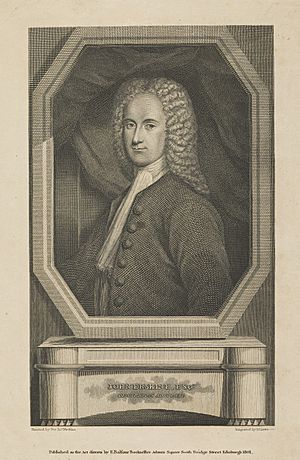John Erskine of Carnock facts for kids
John Erskine of Carnock (born November 4, 1695 – died March 1, 1768) was an important Scottish legal expert. He taught Scottish law at the University of Edinburgh. John Erskine wrote two very important books about Scottish law: Principles of the Law of Scotland and An Institute of the Law of Scotland. These books helped many students understand the laws of Scotland.
Who Was John Erskine?
John Erskine was a member of Clan Erskine, a well-known Scottish family. He was the oldest son of John Erskine of Cardross and Anne Dundas. His father became wealthy by joining the army of William of Orange. This army invaded England in 1688. John Erskine's family had important connections in Scotland.
Erskine's Legal Career
John Erskine studied law and became a lawyer in 1719. He worked as an advocate (a type of lawyer) for several years. In 1737, the position of Professor of Scottish Law at the University of Edinburgh became available. The city council, which chose professors, asked the Faculty of Advocates (a group of lawyers) to suggest names. John Erskine was one of the top choices. This showed how much respect he had earned in the legal world. His family connections also helped him get the job.
As a professor, John Erskine received money each year, plus fees from his students. His lectures were very popular. He decided to write a new textbook for his students. He wanted to update an older book called Institutions of the Law of Scotland. Erskine's new book, Principles of the Law of Scotland, followed a similar structure but added more details. It also brought the information up to date.
Erskine stopped teaching in 1765. He then focused on writing an even bigger book, An Institute of the Law of Scotland. He had almost finished it when he died in 1768. A legal friend, with help from other lawyers, completed the book. This book was part of a big project during the Enlightenment. People wanted to organize and make sense of all the laws.
Erskine's Institute has been printed many times since it first came out in 1773. It is still used today, though it has been updated over the years. Some people thought it was too academic. They felt it did not show enough about how law worked every day. However, it quickly became a trusted source of information. It is probably the most quoted book in Scottish courts.
Erskine's Family Life
John Erskine was married twice. His first wife was Margaret Melville, whom he married in 1719. Their son, John Erskine, became a well-known religious scholar. In 1729, John Erskine married his second wife, Anne Sterling. Several of his grandchildren from his second marriage became famous. These included John Erskine, Sir David Erskine, Sir Arthur Erskine, Sir James Erskine, and Sir George Erskine. John Erskine passed away in March 1768, at the age of 72.


